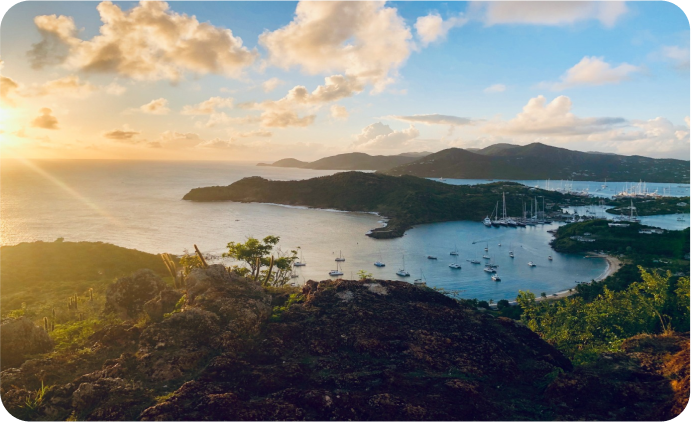Attending Caribbean Medical Schools
Attending a medical school in the Caribbean is a significant life decision, with over 50 distinct medical schools in the region, each offering unique features and attracting a diverse array of students globally. For some, it's an accelerated path to a medical career, while for others, it's the appeal of studying in an exotic location. Choosing this path places you on a unique trajectory compared to most U.S. residency candidates, and understanding its implications is crucial.

Caribbean Medical Schools
Fast Facts: Here are some updated facts about four of the most well-known Caribbean medical schools.

- Year Established: - 1977
- Alumni - Over 20,000
-
Tuition
- Basic Sciences (Term 1-5): $30,012-$49,012 per Term
Clinical Sciences (Term 1-5): $32,505 per Term
4 Years: Approximately $348,486 (Total tuition, not including other fees)
% Passing USMLE Step 1: 89% (average over the last five years, 2018-2022)
Residency Acceptance: Over the last five years, SGU has an 86% US residency placement rate for international graduates.

- Year Established - 1978
- Alumni - Over 15,000
-
Tuition
- Clinical Sciences (Semesters 5-10): $25,893 per semester
4 Years: Total tuition exceeding $265,000 (not including additional fees)
Average MCAT: The latest specific average MCAT score is not listed; however, Ross Med is known for assessing a range of qualifications during admissions.
% Passing USMLE Step 1: The five-year cumulative first-time pass rate for the USMLE Step 1 is 86.8% (2019-2023).
Residency Acceptance: The first-time residency attainment rate for 2023-2024 graduates is 98%.

- Year Established - 1992
- Alumni - Over 3,000
-
Tuition
- Basic Sciences (Terms 1-5): $18,980 per term
Clinical Sciences (Semesters 6-10): $23,300 per semester
4 Years: Over $210,000 (Tuition, not including other fees)
% Passing first time USMLE Step 1: 99% over three years (2021-2023).
Residency Acceptance: 97% (average from 2020-2024).

- Year Established - 1978
- Alumni - Over 7,500
-
Tuition
- Basic Sciences (Semester 1-5): As of 2022, tuition per semester is $26,680.
Clinical Sciences (Semester 6-10): $28,146 per semester
4 Years: The overall cost, not including additional fees such as health and administrative fees, exceeds $226,000.
% Passing USMLE Step 1: 84% first-time pass rate.
Residency Acceptance: 98% first-time residency attainment rate for 2023-2024 graduates.
Accreditation of Caribbean medical schools is crucial for students wishing to practice medicine in the United States, as it affects eligibility for USMLE exams, ECFMG certification, and residency placements. The top Caribbean medical schools that allow graduates to be licensed throughout all 50 states due to their accreditation include.
- St. George's University (SGU)
- Ross University
- American University of the Caribbean (AUC)
- Saba University
- Medical University of the Americas (MUA)
- Spartan Health Sciences University
- Avalon University School of Medicine
St. Matthews University (SMU) is accredited by NCFMEA but is NY Disapproved.
From Medical School to Residency
From Medical School to Residency (2025 NRMP Match Data)
Caribbean medical schools play a critical role in transitioning their students to US residency programs. The latest data from the 2025 Main Residency Match, released by the National Resident Matching Program (NRMP), shows the match rates for International Medical Graduates (IMGs) entering US residency programs.
- A total of 9,761 IMGs secured first-year positions in accredited U.S. GME programs in the 2025 Match, an increase from 2024. Of these, 3,108 are U.S. citizens, while 6,653 are non-U.S. citizens.
- For U.S. citizen IMGs, the PGY-1 match rate was 67.8%, representing a 0.8 percentage point increase over last year.
- For non-U.S. citizen IMGs, the PGY-1 match rate was 58.0%, a slight decrease of 0.5 percentage points compared to last year.
The 2025 Main Residency Match was the largest in NRMP's history, with 52,498 applicants registered and 43,237 total positions offered. IMGs filled more than one-quarter of all matched applicants.
Medical schools and their students should collaborate effectively to enhance USMLE® scores. The school has the responsibility to ensure that students are well-versed in the necessary material to succeed in the USMLE® exams. Additionally, students should proactively engage with their school to devise an optimal exam schedule that aligns with their residency application timeline.
Medical students are encouraged to coordinate closely with their school's clinical rotations coordinator to design rotations that optimally prepare them for residency. Effective clinical rotations not only provide potential interview opportunities at hospitals but also facilitate valuable networking connections.
The Medical Student Performance Evaluation (MSPE), formerly known as the Dean's Letter, offers a comprehensive narrative of a student's medical school performance from the school's perspective. It includes sections on unique characteristics, academic background, a summary of clinical rotations with comments, and an overall evaluation. Students should review their MSPE prior to submission to ensure the accuracy of the information.
Navigating the residency application process can be complex and daunting. Medical students should initiate their preparation early by familiarizing themselves with the residency application steps and maintaining open communication with their medical school advisors to strategically plan their path to residency.